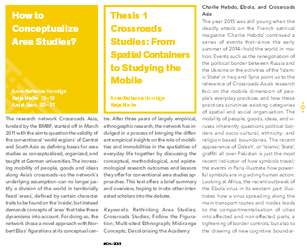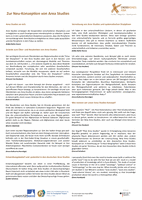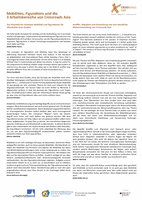How can we conduct and position Area Studies today?
In many parts of the world, we witness an increasing mobility of people, goods, capital and ideas. This fluidity calls for a reconsideration of the division of the world in territorially fixed ‘areas’, defined by certain character traits. The challenge for Area Studies is to develop concepts of ‘area’ that take into account these dynamisms, new interdependencies and spatial formations. At the same time, the increasing complexity of our glocal environments demands innovative approaches to knowledge production on dynamic human interaction processes, only properly understood through multidisciplinary perspectives and reflections on the positionality of the researcher.
With the Crossroads Perspective, we aim to develop an interdisciplinary research paradigm for knowledge generation in an increasingly interrelated world. The perspective is focused on three components:
• developing appropriate theoretical concepts for analyzing interconnectedness (e.g., the "Figurational Construction of Spaces" concept);
• determining key methodological approaches to best capture interdependencies in dynamic spatial formations (e.g., the "Follow the Figuration" method); and
• enabling reflexivity among researchers through critical consideration of positionality in knowledge production.
The Crossroads Perspective is based on seventeen empirical studies undertaken by network members since 2011, with research initiated in, but not limited to, locations ranging from eastern Iran to western China and from the Aral Sea to northern India. Presently, in the project’s second phase, the network intends to consolidate a common research orientation that is comprised of a range of conceptual and methodological tools suitable for interpreting a highly interdependent world. These synthesis efforts draw on seven work packages that provide theoretical breadth and empirical depth to the Crossroads Perspective.
Crossroads Studies: From Spatial Containers to Studying the Mobile
The research network Crossroads Asia, funded by the BMBF, started off in March 2011 with the aim of thinking beyond territorially fixed areas such as Central and South Asia as defining categories for understanding the everyday lives of people along Asia’s crossroads. A short article by Anna-Katharina Hornidge and Katja Mielke, published in Middle East - Topics & Arguments (META), brings together different empirical insights from within the network on the role of mobilities and immobilities in creating transnational and translocal spatialities.
To read the whole article, click here or on the picture above.










